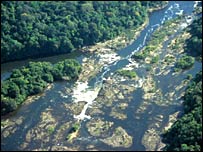
The protected area covers 16.4 million hectares
|
Vast tracts of rainforest in Brazil are to get a new protected status.
The segments of land in the northern Para state together
cover 15 million hectares (57,915 sq miles), an area of land that is
bigger than England.
Thousands of wildlife species inhabit the pristine forest, including jaguars, anteaters and colourful macaws.
Campaigners say the decision made by Para Governor Simao
Jatene is one of the most important conservation initiatives of recent
years.
It will protect the land from the unsustainable logging and agriculture practices that have blighted many parts of the Amazon.
"If any tropical rainforest on Earth remains intact a
century from now, it will be this portion of northern Amazonia, due in
large part to the governor's visionary achievement," said Russell
Mittermeier, president of Conservation International.
"The region has more undisturbed rainforest than
anywhere else, and the new protected areas being created by Para state
represent an historic step toward ensuring that they continue to
conserve the region's rich biodiversity and maintain its essential
ecosystem services."
Conservation corridor
Seven new areas will gain protection, and they will link
with existing reserves to form a huge conservation corridor in the
northern Amazon.
This corridor, known as the Guyana Shield region, stretches from neighbouring Guyana, Surinam and French Guiana into Brazil.
 |
The protected area contains many species of wildlife

|
It is regarded a global conservation priority,
containing more than 25% of Earth's humid tropical forests. Almost 90%
of the Guyana Shield forest is untouched, and the area also contains
the most significant freshwater reserves in the American tropics:
almost 20% of the world's water runs through it.
Endangered species in the new protected areas include
the giant otter and northern bearded saki monkey; and "flagship"
species such as the jaguar, giant anteater and black spider monkey.
Since 1970, more than 600,000 sq kilometres (230,000 sq
miles) of Amazon rainforest - an area larger than France - is said to
have been destroyed.
Conservation International said continued deforestation
at this rate would place the entire region in peril by 2050, and place
increasing pressure on the planet from the additional greenhouse gasses
being pumped into the atmosphere, which would usually stored by the
trees.
Adalberto Verissimo, senior researcher at the Amazon
Institute of People and the Environment (Imazon), which is working in
collaboration with the Para State Government and Conservation
International (CI), said: "This is the greatest effort in history
toward the creation of protected areas in tropical forests."

|


